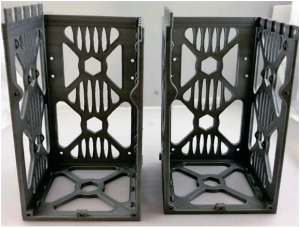 Few things have brought science directly into the hands of the general public more than the CubeSat. Often 3D printed, these miniature satellites can be easily crafted and stocked with experiments. Anyone from professional scientists to grade school students can build CubeSats and see them launched into space as part of rocket payloads. This allows for new discoveries to be made by anyone, and for scientific study to be presented in a hands-on way as never before.
Few things have brought science directly into the hands of the general public more than the CubeSat. Often 3D printed, these miniature satellites can be easily crafted and stocked with experiments. Anyone from professional scientists to grade school students can build CubeSats and see them launched into space as part of rocket payloads. This allows for new discoveries to be made by anyone, and for scientific study to be presented in a hands-on way as never before.
CubeSats can be made simply, or they can also be complex, and 3D printing can easily facilitate either. In a thesis entitled “Design and Testing of an Additively Manufactured CubeSat Structural Bus,” US Air Force Second Lieutenant Karson A. Roberts describes using 3D printing to create a CubeSat structural bus.
“Recent innovations in additive manufacturing and design capabilities have opened the door for more opportunities to integrate multiple functions into a structural design,” says Roberts. “Specifically, 3D printing through advanced laser powder bed fusion of metal powder allows for the development and integration of advanced structures that were previously unachievable.”
Roberts uses the technology to develop a CubeSat bus consisting of various internal and external features, going beyond simply providing structural support and additionally increasing the satellite’s functionality and capabilities. The integrated features include internal lattices and wiring tabs. Roberts used the 3D printers available at the Air Force Institute of Technology (AFIT), which included an Ultimaker 3 and a Concept Laser M2 Cusing printer (The process is also called Selective Laser Melting, Direct Metal Laser Sintering and Powder Bed Fusion).
The Ultimaker 3 was used to create a proof of concept and initial design iterations, while the M2 was used to print the satellite’s metal parts in Inconel 718. The CubeSat bus was designed in SOLIDWORKS, and a lattice generation software called nTopology Element was used to create lattice configurations and patterns that can be inserted into a particular part. Roberts’ research focused specifically on the lattice structures with the aim of making a previously solid structure lighter and stiffer.
“…the latticed design demonstrated mass savings compared to a solid-walled bus with the same dimensions and wall thickness, estimated at 1010.05g,” Roberts says. “This is a 35% reduction in mass compared to the total predicted mass of the male/female design. The actual mass of a solid-walled bus is unknown since it wasn’t fabricated, but the latticed design still would show an 11% reduction in mass, assuming a machined solid-walled structure was exactly the same as the predicted mass.”
The CubeSat structural bus, once it was completed, was then subject to vibration testing to see if it could withstand launch conditions.
“Unfortunately, drops in both natural frequency and peak response at the natural frequency values between the pre and post sine sweep was prevalent in this testing, and didn’t meet the passing criteria as specified by NASA GEVS,” Roberts explains. “The exact reason for this drop is unknown, and requires extensive future studies.”
The study didn’t turn out perfectly, as shown by the vibration testing results, and Roberts also points out that he was limited by the sizes of the 3D printers available. He also states that a better knowledge of the software he used may have benefited him. However, the study did show that lattice designs can greatly reduce the weight and mass of a structure like a CubeSat bus and that 3D printing can effectively create these designs. This is promising for future CubeSat developments.
Discuss this and other 3D printing topics at 3DPrintBoard.com or share your thoughts below.
[Images: Karson A. Roberts]
Subscribe to Our Email Newsletter
Stay up-to-date on all the latest news from the 3D printing industry and receive information and offers from third party vendors.
Print Services
Upload your 3D Models and get them printed quickly and efficiently.
You May Also Like
Making 3D Printing Personal: How Faraz Faruqi Is Rethinking Digital Design at MIT CSAIL
What if your 3D printer could think more like an intelligent assistant, able to reason through a design idea, ask questions, and deliver something that works exactly the way the...
Reinventing Reindustrialization: Why NAVWAR Project Manager Spencer Koroly Invented a Made-in-America 3D Printer
It has become virtually impossible to regularly follow additive manufacturing (AM) industry news and not stumble across the term “defense industrial base” (DIB), a concept encompassing all the many diverse...
Heating Up: 3D Systems’ Scott Green Discusses 3D Printing’s Potential in the Data Center Industry
The relentless rise of NVIDIA, the steadily increasing pledges of major private and public investments in national infrastructure projects around the world, and the general cultural obsession with AI have...
Formlabs Teams Up with DMG MORI in Japan
In late June, Nick Graham, Chief Revenue Officer at Formlabs, announced on LinkedIn that the company had partnered with DMG MORI, one of the world’s leading machine tool companies, to...


































